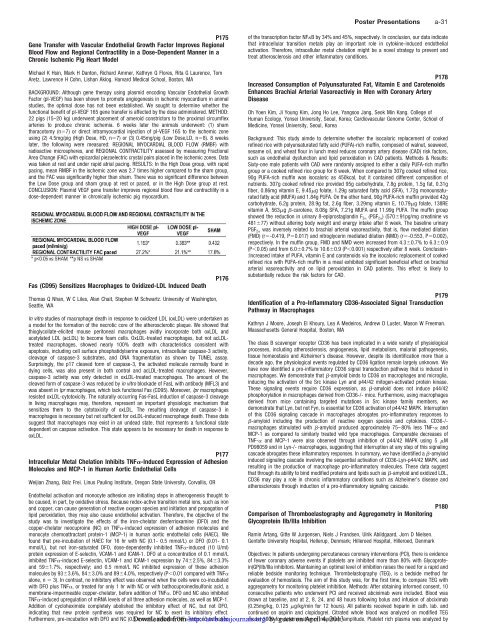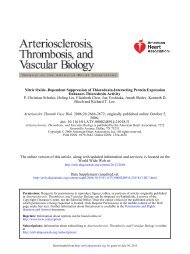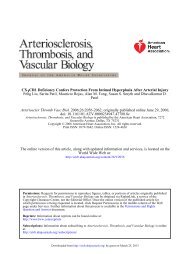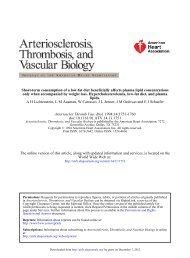Oral Presentations - Arteriosclerosis, Thrombosis, and Vascular ...
Oral Presentations - Arteriosclerosis, Thrombosis, and Vascular ...
Oral Presentations - Arteriosclerosis, Thrombosis, and Vascular ...
Create successful ePaper yourself
Turn your PDF publications into a flip-book with our unique Google optimized e-Paper software.
P175<br />
Gene Transfer with <strong>Vascular</strong> Endothelial Growth Factor Improves Regional<br />
Blood Flow <strong>and</strong> Regional Contractility in a Dose-Dependent Manner in a<br />
Chronic Ischemic Pig Heart Model<br />
Michael K Hsin, Mark H Danton, Richard Ammer, Kathryn Q Flores, Rita G Laurence, Tom<br />
Aretz, Lawrence H Cohn, Lishan Aklog. Harvard Medical School, Boston, MA<br />
BACKGROUND: Although gene therapy using plasmid encoding <strong>Vascular</strong> Endothelial Growth<br />
Factor (pl-VEGF) has been shown to promote angiogenesis in ischemic myocardium in animal<br />
studies, the optimal dose has not been established. We sought to determine whether the<br />
functional benefit of pl-VEGF 165 gene transfer is affected by the dose administered. METHOD:<br />
22 pigs (15–20 kg) underwent placement of ameroid constrictors to the proximal circumflex<br />
arteries to produce chronic ischemia. 6 weeks later the animals underwent: (1) sham<br />
thoracotomy (n7) or direct intramyocardial injection of pl-VEGF 165 to the ischemic zone<br />
using (2) 4.5mg/pig (High Dose, HD, n7) or (3) 0.45mg/pig (Low Dose,LD, n8). 8 weeks<br />
later, the following were measured: REGIONAL MYOCARDIAL BLOOD FLOW (RMBF) with<br />
radioactive microspheres, <strong>and</strong> REGIONAL CONTRACTILITY assessed by measuring Fractional<br />
Area Change (FAC) with epicardial piezoelectric crystal pairs placed in the ischemic zones. Data<br />
was taken at rest <strong>and</strong> under rapid atrial pacing. RESULTS: In the High Dose group, with rapid<br />
pacing, mean RMBF in the ischemic zone was 2.7 times higher compared to the sham group,<br />
<strong>and</strong> the FAC was significantly higher than sham. There was no significant difference between<br />
the Low Dose group <strong>and</strong> sham group at rest or paced, or in the High Dose group at rest.<br />
CONCLUSION: Plasmid VEGF gene transfer improves regional blood flow <strong>and</strong> contractility in a<br />
dose-dependent manner in chronically ischemic pig myocardium.<br />
Fas (CD95) Sensitizes Macrophages to Oxidized-LDL Induced Death<br />
Thomas Q Nhan, W C Liles, Alan Chait, Stephen M Schwartz. University of Washington,<br />
Seattle, WA<br />
P176<br />
In vitro studies of macrophage death in response to oxidized LDL (oxLDL) were undertaken as<br />
a model for the formation of the necrotic core of the atherosclerotic plaque. We showed that<br />
thioglycollate-elicited mouse peritoneal macrophages avidly incorporate both oxLDL <strong>and</strong><br />
acetylated LDL (acLDL) to become foam cells. OxLDL-treated macrophages, but not acLDLtreated<br />
macrophages, showed nearly 100% death with characteristics consistent with<br />
apoptosis, including cell surface phosphatidylserine exposure, intracellular caspase-3 activity,<br />
cleavage of caspase-3 substrates, <strong>and</strong> DNA fragmentation as shown by TUNEL assay.<br />
Surprisingly, the p17 cleaved form of caspase-3, the activated molecule normally found in<br />
dying cells, was also present in both control <strong>and</strong> acLDL-treated macrophages. However,<br />
caspase-3 activity was only detected in oxLDL-treated macrophages. The amount of the<br />
cleaved form of caspase-3 was reduced by in vitro blockade of FasL with antibody (MFL3) <strong>and</strong><br />
was absent in lpr macrophages, which lack functional Fas (CD95). Moreover, lpr macrophages<br />
resisted oxLDL-cytotoxicity. The naturally occurring Fas-FasL induction of caspase-3 cleavage<br />
in living macrophages may, therefore, represent an important physiologic mechanism that<br />
sensitizes them to the cytotoxicity of oxLDL. The resulting cleavage of caspase-3 in<br />
macrophages is necessary but not sufficient for oxLDL-induced macrophage death. These data<br />
suggest that macrophages may exist in an undead state, that represents a functional state<br />
dependent on caspase activation. This state appears to be necessary for death in response to<br />
oxLDL.<br />
P177<br />
Intracellular Metal Chelation Inhibits TNF-Induced Expression of Adhesion<br />
Molecules <strong>and</strong> MCP-1 in Human Aortic Endothelial Cells<br />
Weijian Zhang, Balz Frei. Linus Pauling Institute, Oregon State University, Corvallis, OR<br />
Endothelial activation <strong>and</strong> monocyte adhesion are initiating steps in atherogenesis thought to<br />
be caused, in part, by oxidative stress. Because redox-active transition metal ions, such as iron<br />
<strong>and</strong> copper, can cause generation of reactive oxygen species <strong>and</strong> initiation <strong>and</strong> propagation of<br />
lipid peroxidation, they may also cause endothelial activation. Therefore, the objective of the<br />
study was to investigate the effects of the iron-chelator desferrioxamine (DFO) <strong>and</strong> the<br />
copper-chelator neocuproine (NC) on TNF-induced expression of adhesion molecules <strong>and</strong><br />
monocyte chemoattractant protein-1 (MCP-1) in human aortic endothelial cells (HAEC). We<br />
found that pre-incubation of HAEC for 16 hr with NC (0.1- 0.5 mmol/L) or DFO (0.01- 0.1<br />
mmol/L), but not iron-saturated DFO, dose-dependently inhibited TNF-induced (10 U/ml)<br />
protein expression of E-selectin, VCAM-1 <strong>and</strong> ICAM-1. DFO at a concentration of 0.1 mmol/L<br />
inhibited TNF-induced E-selectin, VCAM-1 <strong>and</strong> ICAM-1 expression by 742.5%, 843.3%<br />
<strong>and</strong> 591.7%, respectively; <strong>and</strong> 0.5 mmol/L NC inhibited expression of these adhesion<br />
molecules by 933.6%, 843.0% <strong>and</strong> 894.0%, respectively (P0.01 compared with TNF<br />
alone, n 3). In contrast, no inhibitory effect was observed when the cells were co-incubated<br />
with DFO plus TNF, or treated for only 1 hr with NC or with bathocuproinedisulfonic acid, a<br />
membrane-impermeable copper-chelator, before addition of TNF. DFO <strong>and</strong> NC also inhibited<br />
TNF-induced upregulation of mRNA levels of all three adhesion molecules, as well as MCP-1.<br />
Addition of cycloheximide completely abolished the inhibitory effect of NC, but not DFO,<br />
indicating that new protein synthesis was required for NC to exert its inhibitory effect.<br />
Furthermore, pre-incubation with DFO <strong>and</strong> NC (0.5 Downloaded mmol/L) inhibitedfrom TNF-induced activation<br />
http://atvb.ahajournals.org/<br />
Poster <strong>Presentations</strong> a-31<br />
of the transcription factor NFB by 34% <strong>and</strong> 45%, respectively. In conclusion, our data indicate<br />
that intracellular transition metals play an important role in cytokine-induced endothelial<br />
activation. Therefore, intracellular metal chelation might be a novel strategy to prevent <strong>and</strong><br />
treat atherosclerosis <strong>and</strong> other inflammatory conditions.<br />
P178<br />
Increased Consumption of Polyunsaturated Fat, Vitamin E <strong>and</strong> Carotenoids<br />
Enhances Brachial Arterial Vasoreactiviy in Men with Coronary Artery<br />
Disease<br />
Oh Yoen Kim, Ji Young Kim, Jong Ho Lee, Yangsoo Jang, Seok Min Kang. College of<br />
Human Ecology, Yonsei University, Seoul, Korea; Cardiovascular Genome Center, School of<br />
Medicine, Yonsei University, Seoul, Korea<br />
Background: This study aimde to determine whether the isocaloric replacement of cooked<br />
refined rice with polyunsaturated fatty acid (PUFA)-rich muffin, composed of walnut, seaweed,<br />
sesame oil, <strong>and</strong> wheat flour in lunch meal reduces coronary artery disease (CAD) risk factors,<br />
such as endothelial dysfunction <strong>and</strong> lipid peroxidation in CAD patients. Methods & Results:<br />
Sixty-one male patients with CAD were r<strong>and</strong>omly assigned to either a daily PUFA-rich muffin<br />
group or a cooked refined rice group for 8 week. When compared to 307g cooked refined rice,<br />
90g PUFA-rich muffin was isocaloric as 450kcal, but it contained different composition of<br />
nutrients. 307g cooked refined rice provided 95g carbohydrate, 7.8g protein, 1.5g fat, 0.31g<br />
fiber, 0.86mg vitamin E, 9.45g folate, 1.29g saturated fatty acid (SFA), 1.72g monounsaturated<br />
fatty acid (MUFA) <strong>and</strong> 1.84g PUFA. On the other h<strong>and</strong>, 90g PUFA-rich muffin provided 42g<br />
carbohydrate, 6.2g protein, 28.9g fat, 2.6g fiber, 3.29mg vitamin E, 10.79g folate, 138RE<br />
vitamin A, 563g -carotene, 8.08g SFA, 7.21g MUFA <strong>and</strong> 11.99g PUFA. The muffin group<br />
showed the reduction in urinary 8-epiprostagl<strong>and</strong>in F 2 (PGF 2) (57091pg/mg creatinine vs<br />
48177) without altering body weight <strong>and</strong> energy intake after 8 week. The baseline urinary<br />
PGF 2 was inversely related to brachial arterial vasoreactivity, that is, flow mediated dilation<br />
(FMD) (r-0.419, P0.017) <strong>and</strong> nitroglycerin mediated dilation (NMD) (r-0.553, P0.002),<br />
respectively. In the muffin group, FMD <strong>and</strong> NMD were increased from 4.30.7% to 6.30.9<br />
(P0.05) <strong>and</strong> from 6.00.7% to 10.60.9 (P0.001) respectively after 8 week. Conclusion-<br />
:Increased intake of PUFA, vitamin E <strong>and</strong> carotenoids via the isocaloric replacement of cooked<br />
refined rice with PUFA-rich muffin in a meal exhibited significant beneficial effect on brachial<br />
arterial vasoreactivity <strong>and</strong> on lipid peroxidation in CAD patients. This effect is likely to<br />
substantially reduce the risk factors for CAD.<br />
P179<br />
Identification of a Pro-Inflammatory CD36-Associated Signal Transduction<br />
Pathway in Macrophages<br />
Kathryn J Moore, Joseph El Khoury, Lea A Medeiros, Andrew D Luster, Mason W Freeman.<br />
Massachusetts General Hospital, Boston, MA<br />
The class B scavenger receptor CD36 has been implicated in a wide variety of physiological<br />
processes, including atherosclerosis, angiogenesis, lipid metabolism, malarial pathogenesis,<br />
tissue homeostasis <strong>and</strong> Alzheimer’s disease. However, despite its identification more than a<br />
decade ago, the physiological events regulated by CD36 ligation remain largely unknown. We<br />
have now identified a pro-inflammatory CD36 signal transduction pathway that is induced in<br />
macrophages. We demonstrate that -amyloid binds to CD36 on macrophages <strong>and</strong> microglia,<br />
inducing the activation of the Src kinase Lyn <strong>and</strong> p44/42 mitogen-activated protein kinase.<br />
These signaling events require CD36 expression, as -amyloid does not induce p44/42<br />
phosphorylation in macrophages derived from CD36-/- mice. Furthermore, using macrophages<br />
derived from mice containing targeted mutations in Src kinase family members, we<br />
demonstrate that Lyn, but not Fyn, is essential for CD36 activation of p44/42 MAPK. Interruption<br />
of this CD36 signaling cascade in macrophages abrogates pro-inflammatory responses to<br />
-amyloid including the production of reactive oxygen species <strong>and</strong> cytokines. CD36-/macrophages<br />
stimulated with -amyloid produced approximately 75–80% less TNF- <strong>and</strong><br />
MCP-1 as compared to similarly treated wild type macrophages. Comparable decreases of<br />
TNF- <strong>and</strong> MCP-1 were also observed through inhibition of p44/42 MAPK using 5 M<br />
PD98059 <strong>and</strong> in Lyn-/- macrophages, suggesting that interruption at any step of this signaling<br />
cascade abrogates these inflammatory responses. In summary, we have identified a -amyloid<br />
induced signaling cascade involving the sequential activation of CD36-Lyn-p44/42 MAPK, <strong>and</strong><br />
resulting in the production of macrophage pro-inflammatory molecules. These data suggest<br />
that through its ability to bind modified proteins <strong>and</strong> lipids such as -amyloid <strong>and</strong> oxidized LDL,<br />
CD36 may play a role in chronic inflammatory conditions such as Alzheimer’s disease <strong>and</strong><br />
atherosclerosis through induction of a pro-inflammatory signaling cascade.<br />
Comparison of Thromboelastography <strong>and</strong> Aggregometry in Monitoring<br />
Glycoprotein IIb/IIIa Inhibition<br />
Ramin Artang, Gitte W Jurgensen, Niels J Fr<strong>and</strong>sen, Ulrik Abildgaard, Jorn D Nielsen.<br />
Gentofte University Hospital, Hellerup, Denmark; Hilleroed Hospital, Hilleroed, Denmark<br />
P180<br />
Objectives: In patients undergoing percutaneous coronary interventions (PCI), there is evidence<br />
of fewer coronary adverse events if platelets are inhibited more than 80% with Glycoprotein(GP)IIb/IIIa<br />
inhibitors. Maintaining an optimal level of inhibition raises the need for a rapid <strong>and</strong><br />
reliable bedside monitoring technique. Thrombelastography (TEG), is a bedside method for<br />
evaluation of hemostasis. The aim of this study was, for the first time, to compare TEG with<br />
aggregometry for monitoring platelet inhibition. Methods: After obtaining informed consent, 10<br />
consecutive patients who underwent PCI <strong>and</strong> received abciximab were included. Blood was<br />
drawn at baseline, <strong>and</strong> at 2, 8, 24, <strong>and</strong> 48 hours following bolus <strong>and</strong> infusion of abciximab<br />
(0.25mg/kg, 0.125 g/kg/min for 12 hours). All patients received heparin in cath. lab. <strong>and</strong><br />
continued on aspirin <strong>and</strong> clopidogrel. Citrated whole blood was analyzed on modified TEG<br />
model 5000 by for guest determination on April of maximum 4, 2013amplitude.<br />
Platelet rich plasma was analyzed by














